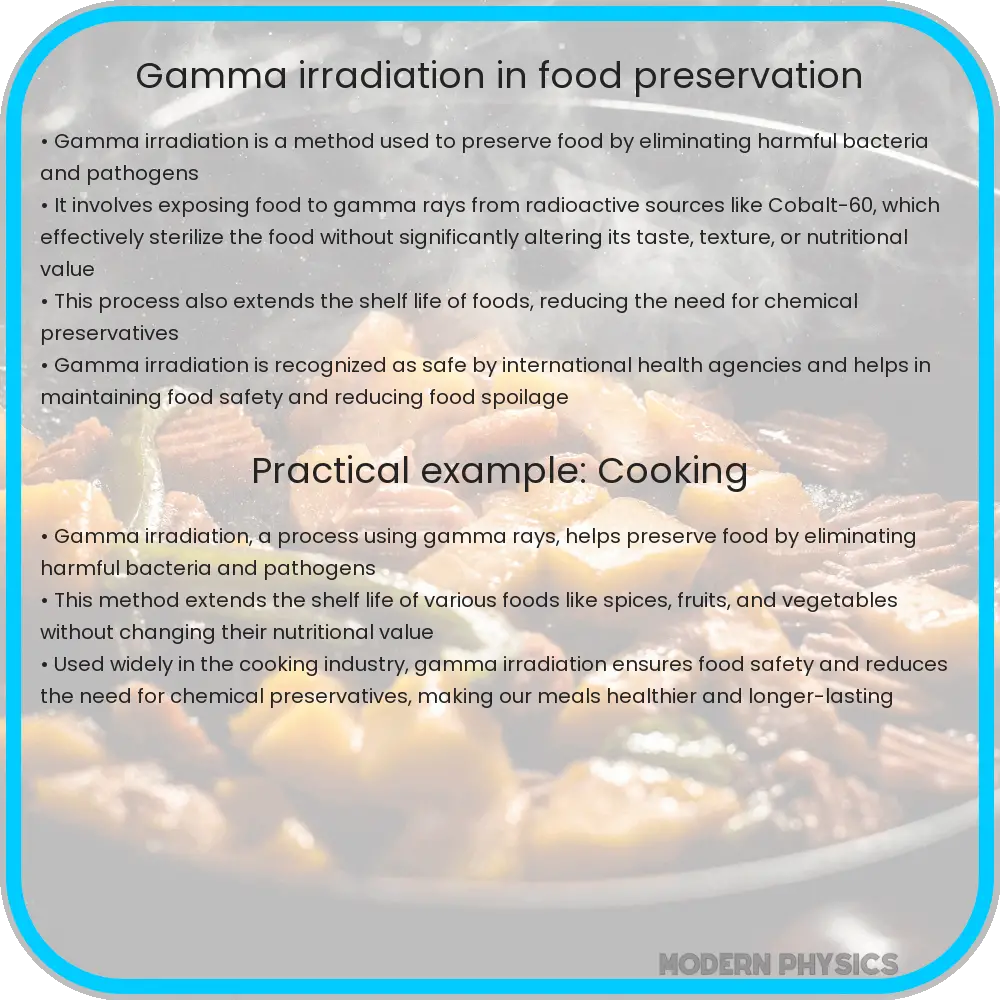Gamma irradiation is a method used to preserve food, enhance safety, and extend shelf life by using gamma rays to destroy harmful pathogens.

Understanding Gamma Irradiation in Food
Gamma irradiation, a type of ionizing radiation, is increasingly used as a method to preserve food, enhance food safety, and extend shelf life. This technology utilizes gamma rays, typically from sources like Cobalt-60 or Cesium-137, to eliminate potential pathogens and spoilage microorganisms from food products. The process is fascinating not just from a scientific standpoint, but also due to its practical implications for food storage and safety.
How Does Gamma Irradiation Work?
Gamma rays are a form of electromagnetic radiation—like X-rays or visible light—but with a much higher energy level. When food products are exposed to gamma rays, the energy transmitted by these rays breaks down the DNA of harmful bacteria, viruses, and parasites. This destruction of DNA prevents the organisms from reproducing and causing illness or spoiling the food. Importantly, the food itself does not become radioactive because gamma rays do not carry enough energy to induce radioactivity in the irradiated items.
Uses of Gamma Irradiation in Food Processing
- Disinfection and Sterilization: Gamma irradiation is effective in killing bacteria, molds, yeast, and insects, significantly reducing the load of microorganisms and increasing the hygienic quality of food products.
- Extending Shelf Life: By controlling spoilage organisms, irradiation helps in prolonging the shelf life of perishables like fruits, vegetables, and meats. This is particularly important for maintaining freshness during transport and storage over long distances.
- Eliminating Pathogens: Foods can be sources of pathogens such as Salmonella, E.coli, and Listeria. Gamma irradiation helps to eliminate these pathogens, reducing the risk of foodborne diseases.
- Insect Disinfestation: It is also used to eliminate insects from grains and fruits, a process mandatory in certain countries for imported foods.
- Delay in Sprouting: In tubers like potatoes, gamma irradiation is used to inhibit sprouting, thus enabling longer storage under ambient conditions.
- Control of Food Ripening: The technique can be adjusted to control the ripening of fruits, avoiding premature spoilage and maintaining texture and nutritional quality.
Benefits of Gamma Irradiation
One of the key benefits of gamma irradiation is its ability to preserve food without significant changes in taste, texture, or nutritional value. Unlike traditional methods such as canning or heat pasteurization, which can alter the chemical composition of food, gamma irradiation is a “cold process” and can maintain the freshness and original quality of the food. Additionally, it is an environmentally friendly process as it reduces the need for chemical preservatives and can contribute to reducing food waste.
Gamma irradiation also plays a significant role in global trade. By eliminating pathogens and pests, this technology meets the stringent sanitary and phytosanitary standards required in international food markets, aiding in the export and import of food products across borders without risking public health.
Safety and Regulation
The use of gamma irradiation in food processing is strictly regulated by international bodies like the World Health Organization (WHO) and the Food and Agriculture Organization (FAO), as well as national health and safety agencies. The process is only approved after thorough assessments to ensure that it does not compromise food safety or nutritional quality. Legitimized by scientific evidence, it has been deemed safe for food treatment and is endorsed globally, provided that operational guidelines are meticulously followed.
Public Perception and Challenges
Despite its numerous benefits, public acceptance of gamma irradiated foods remains a challenge. Misconceptions about the process leading to radioactive foods persist, despite scientific evidence to the contrary. Education and transparent communication are essential in raising public awareness and acceptance. Efforts need to be made to explain how gamma irradiation is different from radioactive contamination and how it helps in maintaining food safety and quality.
Future Prospects
Looking ahead, the future of gamma irradiation in food processing looks promising. Advances in technology may lead to more efficient and cost-effective irradiation facilities, potentially making it more accessible to food producers worldwide. Research is also being directed towards understanding the subtle changes that irradiation may induce in different foods, aiming to optimize process parameters for different types of food products. This could broaden the applications of gamma irradiation, further benefiting global food security and public health.
Conclusion
Gamma irradiation stands out as a highly effective method for increasing the safety and extending the shelf life of food products. By controlling or eliminating spoilage organisms and pathogens without compromising food quality, it supports global food distribution networks and contributes to the reduction of food wastage. Although regulated and accepted by numerous global health organizations, there is still a need for continued public education to demystify the process and encourage broader acceptance. With ongoing advancements and increased understanding of its scientific foundations, gamma irradiation is poised to play an even more significant role in food safety and preservation in the years to come.
